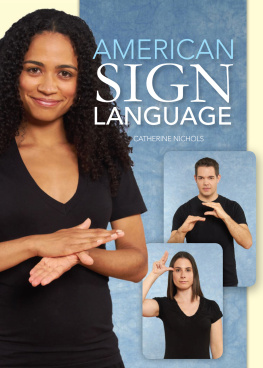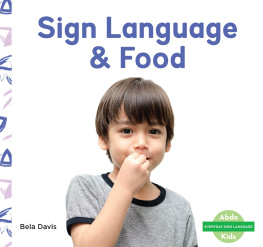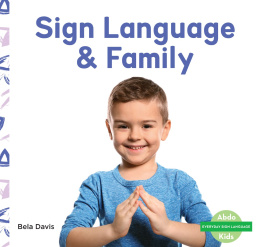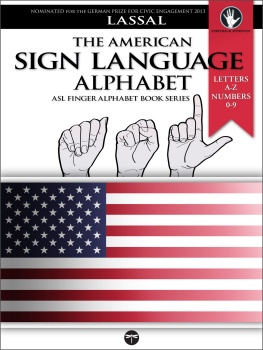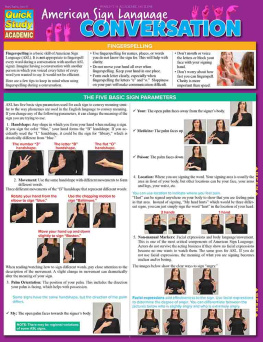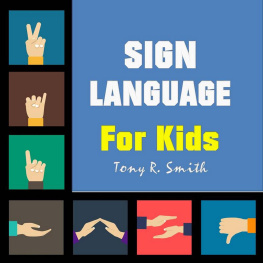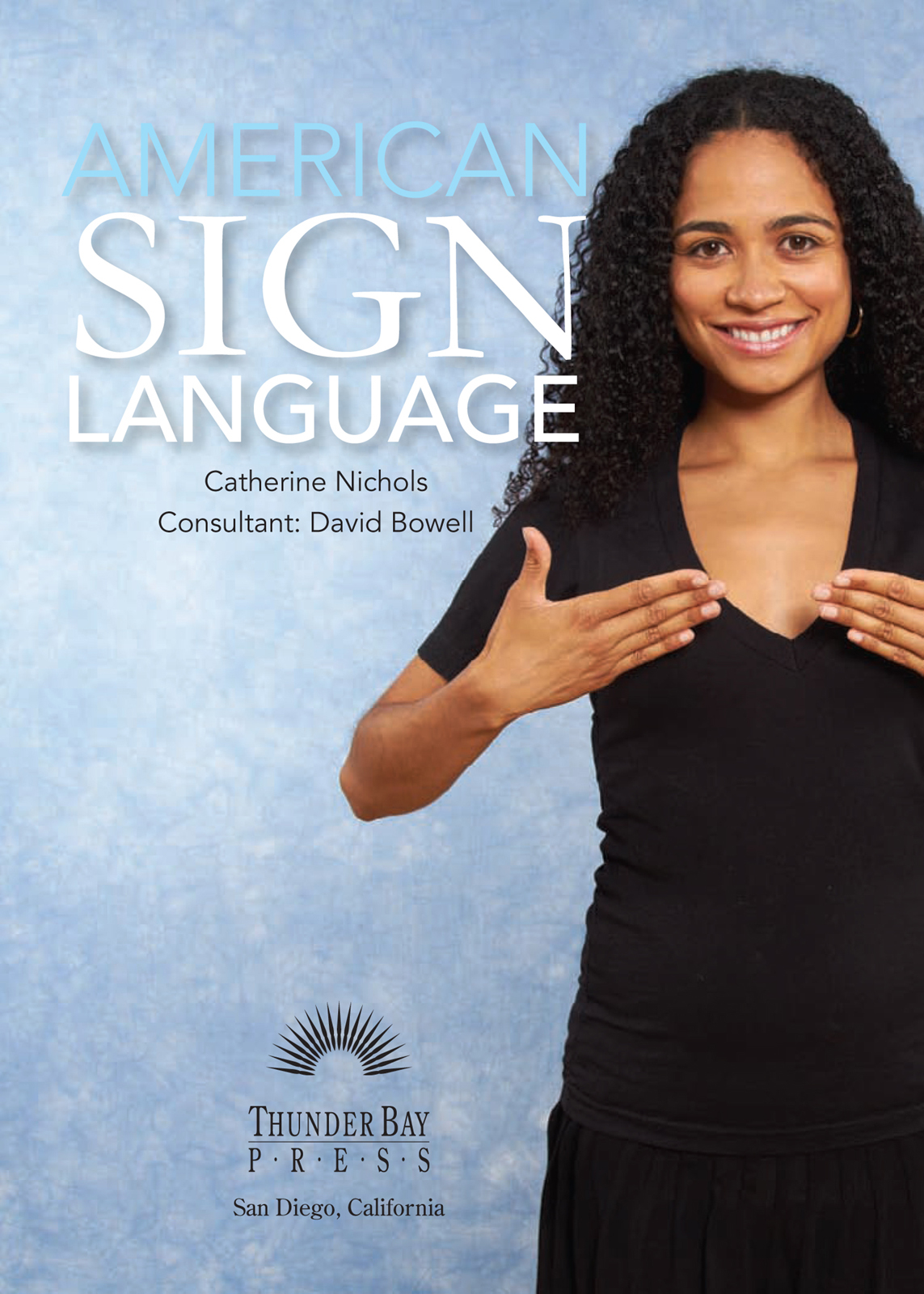Thunder Bay Press
An imprint of the Baker & Taylor Publishing Group
10350 Barnes Canyon Road, San Diego, CA 92121
www.thunderbaybooks.com
Copyright 2011 Thunder Bay Press
Developed by The Book Shop, Ltd.
Designed by Tim Palin
Book photography by Cary Bower
Video photography for DVD by Dino Castelli
Photograph of Marthas Vineyard on page 7 iStockphoto
Photograph of I. King Jordan on page 15 courtesy of Gallandet University Archives
ACKNOWLEDGMENTS:
The Book Shop, Ltd. would like to thank the models Lauren Ridloff, Darren Fudenske, and Keri Horowitz, as
well as Chris Hughlett, executive producer of photography for the book and DVD.
Catherine Nichols would like to thank Michelle Corallo of the Pennsylvania School of the Deaf for her help
and patience.
Copyright under International Pan American and Universal Copyright Conventions. All rights reserved.
No part of this book can be reproduced or transmitted in any form or by any means, electronic or
mechanical, including photocopying, recording, or by any information storage and retrieval system,
without written permission from the copyright holder. Brief passages (not to exceed 1,000 words) may
be quoted for reviews.
Thunder Bay is a registered trademark of Baker & Taylor. All rights reserved.
All notations of errors or omissions should be addressed to Thunder Bay Press, Editorial Department, at
the above address. All other correspondence (author inquiries, permissions) concerning the content of this
book should be addressed to The Book Shop, Ltd., New York, New York 10010. www.thebookshopltd.com
ISBN-13: 978-1-60710-498-8
Printed in China
1 2 3 4 5 15 14 13 12 11
Contents
Dear Reader,
On behalf of the Deaf community, I would like to welcome you to a
wonderful journey of learning American Sign Language.
How long does it take to learn ASL? is a question I am asked often.
My consistent reply is forever. As with any other language, you are
always learning new words, new signs, and new ways of expressing
yourself. It takes at least a few years before you are somewhat fluent,
and many more before you have native-like signing. Even I am still
learning.
However, do not let this discourage you from beginning this journey.
By doing so, you will be able to communicate with the hundreds of
thousands of Deaf individuals in the United States. Whatever your
occupation or position, Deaf people from various walks of life are
appreciative of people who take the time to learn our language. The
more people who can sign, the less communication barriers we face in
our everyday lives.
As you practice and become proficient in ASL, you will also learn
about the Deaf community and our culture. It is a culture steeped in
rich history and heritage, and a very inclusive community.
The Chinese philosopher Laozi said A journey of a thousand miles
begins with a single step. Let this book be your initial step to learning,
and becoming fluent, in ASL.
Enjoy, and happy learning!
David Bowell
Consultant
Introduction
American Sign Language (ASL), one of the worlds most
expressive languages, utilizes the entire body to communicate.
A unique and complex language, ASL should not be considered
an offspring of English or any other spoken language.
Approximately 500,000 deaf and hard of hearing people, their
family members, and people who work in the Deaf community
use this visual language made up of hand shapes, facial
expressions, and body postures to communicate. In fact, it is the
fourth-most studied language in the United States.
This book is designed as your entry into the world of ASL. It is
structured so that you can progress naturally in your ability to
sign, with each chapter serving as a building block to the next.
After an introduction to the rudimentary rules behind ASL, youll
get started by learning how to form the letters of the alphabet.
After that, youll master how to introduce yourself to others and
how to ask questions. From there, youll have the opportunity
to learn signs for numerous objects and people, signs that
denote actions, as well as descriptive signs, such as colors. The
final chapter is devoted to number and time signs. A series of
practice sentences and a list of additional sources to further your
education conclude the book.
To help you master ASL, included in this kit is a set of sixty
four two-sided flashcards. Designed to be portable, the cards
can travel with you wherever you go. If you find yourself with
free timeperhaps youre stuck standing in line or waiting in a
doctors officepull out the deck and practice your signs. The
kit also comes with its own DVD so that you can view each sign
being performed by an experienced ASL signer.
Your journey through the fascinating language of ASL is about
to begin. Roll back your sleeves and get ready to sign.
GETTING
STARTED
Before you begin
signing, you need to
know a little about
the history of ASL,
as well as strategies
for mastering the
language, such as its
grammar and syntax.
The History
of ASL
While people from the earliest
times have used hand gestures
to communicate, the model
for ASL has a more recent
history, one going back to
1814. That was when Thomas
Hopkins Gallaudet, a minister,
met Alice Cogswell, his nine
year-old neighbor. Alice, an
exceptionally bright girl, had
lost her hearing and speech
to a bout of meningitis when
she was a toddler. At the
time, there was no formal
educational system for the deaf
in the United States. In Europe,
however, such schools existed.
In his quest to help teach
Alice and other children like
her, Gallaudet traveled first to
Great Britain to meet a Scottish
family who had taught their
deaf child to communicate
using an oral method. The
family, however, was reluctant
to share its methods. Gallaudet
then traveled to France and
studied at a school that taught manual communication to the
deaf. There he met Laurent Clerc, a deaf man who excelled in
teaching French Sign Language. After Clerc taught Gallaudet
the language, the two men made plans to open a school for the

